2011 Peugeot 3008 Hybrid 4 ignition
[x] Cancel search: ignitionPage 134 of 280
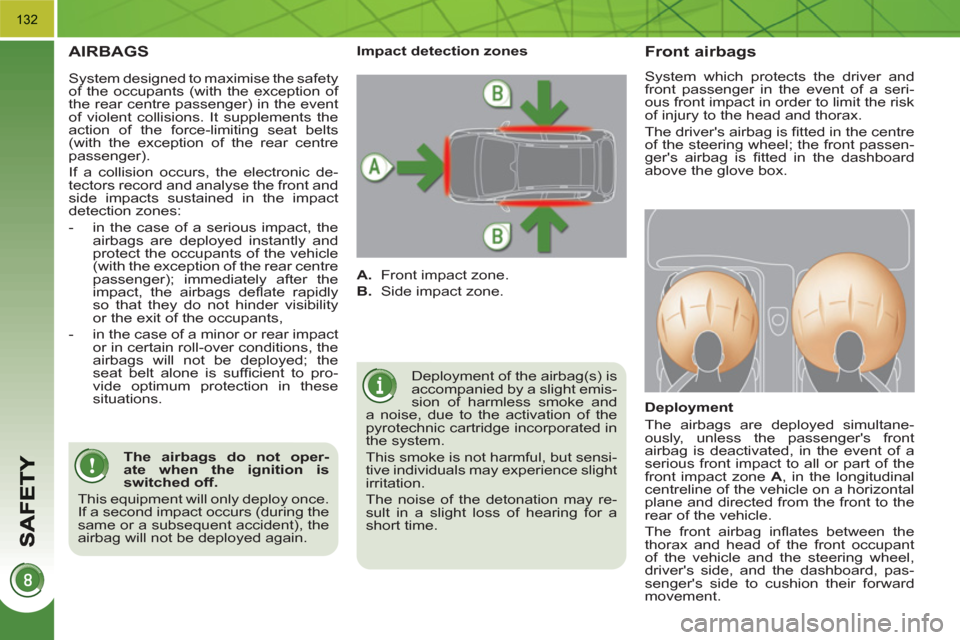
132
AIRBAGS
Deployment of the airbag(s) is
accompanied by a slight emis-
sion of harmless smoke and
a noise, due to the activation of the
pyrotechnic cartridge incorporated in
the system.
This smoke is not harmful, but sensi-
tive individuals may experience slight
irritation.
The noise of the detonation may re-
sult in a slight loss of hearing for a
short time.
Front airbags
System which protects the driver and
front passenger in the event of a seri-
ous front impact in order to limit the risk
of injury to the head and thorax.
The driver's airbag is fi tted in the centre
of the steering wheel; the front passen-
ger's airbag is fi tted in the dashboard
above the glove box.
Deployment
The airbags are deployed simultane-
ously, unless the passenger's front
airbag is deactivated, in the event of a
serious front impact to all or part of the
front impact zone A
, in the longitudinal
centreline of the vehicle on a horizontal
plane and directed from the front to the
rear of the vehicle.
The front airbag infl ates between the
thorax and head of the front occupant
of the vehicle and the steering wheel,
driver's side, and the dashboard, pas-
senger's side to cushion their forward
movement.
Impact detection zones
A.
Front impact zone.
B.
Side impact zone.
The airbags do not oper-
ate when the ignition is
switched off.
This equipment will only deploy once.
If a second impact occurs (during the
same or a subsequent accident), the
airbag will not be deployed again.
System designed to maximise the safety
of the occupants (with the exception of
the rear centre passenger) in the event
of violent collisions. It supplements the
action of the force-limiting seat belts
(with the exception of the rear centre
passenger).
If a collision occurs, the electronic de-
tectors record and analyse the front and
side impacts sustained in the impact
detection zones:
- in the case of a serious impact, the
airbags are deployed instantly and
protect the occupants of the vehicle
(with the exception of the rear centre
passenger); immediately after the
impact, the airbags defl ate rapidly
so that they do not hinder visibility
or the exit of the occupants,
- in the case of a minor or rear impact
or in certain roll-over conditions, the
airbags will not be deployed; the
seat belt alone is suffi cient to pro-
vide optimum protection in these
situations.
Page 135 of 280

133
If at least one of the two airbag
warning lamps come on con-
tinuously, do not install a child
seat on the front passenger seat.
Have the system checked by a
PEUGEOT dealer.
Operating fault
If this warning lamp comes on in
the instrument panel, accompa-
nied by an audible warning and
a message in the multifunction
screen, contact a PEUGEOT
dealer to have the system checked. The
airbags may no longer be deployed in the
event of a serious impact.
Reactivation
When you remove the child seat, turn
the switch to the "ON"
position to re-
activate the airbag and so assure the
safety of your front passenger in the
event of an impact.
With the ignition on, this warn-
ing lamp comes on in the seat
belt and passenger's front air-
bag warning lamps display for
approximately one minute, if
the passenger's front airbag is
activated. To assure the safety of your
child, the passenger's front
airbag must be deactivated
when you install a "rear facing" child
seat on the front passenger seat.
Otherwise, the child would risk being
seriously injured or killed if the airbag
were deployed.
According to version, this
warning lamp comes on either
in the instrument panel or in
the seat belt and passenger's
front airbag warning lamps
display when the ignition is on and until
the airbag is reactivated. If this warning lamp fl ashes,
contact a PEUGEOT dealer.
The passenger's front airbag
may no longer be deployed in
the event of a serious impact.
Deactivation
Only the passenger's front airbag can
be deactivated:
�)
with the ignition off
, insert the key
in the passenger airbag deactivation
switch,
�)
turn it to the "OFF"
position,
�)
then, remove the key keeping the
switch in the new position.
Page 139 of 280

137
With the vehicle stationary, to apply the
parking brake whether the engine is
running or off, pull
on control lever A
.
The application of the parking brake is
confi rmed by:
-
lighting of the braking warn-
ing lamp and of the warning
lamp P
in the control lever A
,
When the driver’s door is opened with
the engine running, there is an audible
signal and a message is displayed if
the parking brake has not been applied,
unless the gear lever is in position P
(Park).
Manual release
With the ignition on or the engine run-
ning, to release the parking brake, press
on the brake
pedal
or the accelerator,
pull then release
control lever A
.
The full application of the parking brake
is confi rmed by:
-
extinction of the braking warn-
ing lamp and of the warning
lamp P
in control lever lever A
,
If you pull control lever A
with-
out pressing the brake pedal,
the parking brake will not be
released and a warning lamp
will come on in the instrument
panel.
Manual applicationMaximum application
If necessary, you can utilise maximum
application
of the parking brake. It is
obtained by means of a long pull
on
control lever A
, until you see the mes-
sage "Handbrake on" and an audible
signal is heard.
In the case of towing, a loaded
vehicle or parking on a gradient,
make a maximum application
of the parking brake then turn the front
wheels towards the pavement and en-
gage a gear when you park.
After a maximum application, the re-
lease time will be longer.
Before leaving the vehicle,
check that parking brake
warning lamp in the instrument
panel is on fi xed, not fl ashing.
Maximum application is essential:
- in the case of a vehicle towing a
caravan or a trailer, if the automatic
functions are activated but you are
applying the parking brake manually,
- when the gradient you are parked
on is variable in its effect (e.g. on a
ferry, in a lorry, during towing),
- display of the message
"Handbrake on".
- display of the message
"Handbrake off".
Page 140 of 280
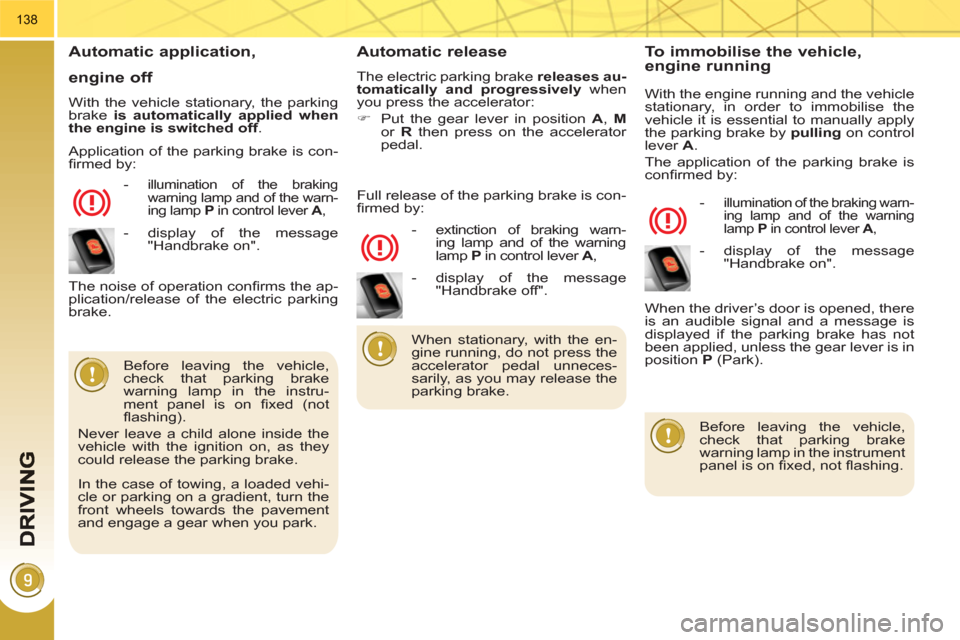
138
Automatic application,
engine off
With the vehicle stationary, the parking
brake is automatically applied when
the engine is switched off.
-
illumination of the braking
warning lamp and of the warn-
ing lamp P
in control lever A
,
Automatic release
The electric parking brake releases au-
tomatically and progressively
when
you press the accelerator:
�)
Put the gear lever in position A
, M
or R
then press on the accelerator
pedal.
Before leaving the vehicle,
check that parking brake
warning lamp in the instru-
ment panel is on fi xed (not
fl ashing).
Never leave a child alone inside the
vehicle with the ignition on, as they
could release the parking brake.
- extinction of braking warn-
ing lamp and of the warning
lamp P
in control lever A
,
The noise of operation confi rms the ap-
plication/release of the electric parking
brake. Full release of the parking brake is con-
fi rmed by:
To immobilise the vehicle, engine running
With the engine running and the vehicle
stationary, in order to immobilise the
vehicle it is essential to manually apply
the parking brake by pulling
on control
lever A
.
The application of the parking brake is
confi rmed by:
-
illumination of the braking warn-
ing lamp and of the warning
lamp P
in control lever A
,
When the driver’s door is opened, there
is an audible signal and a message is
displayed if the parking brake has not
been applied, unless the gear lever is in
position P
(Park).
Before leaving the vehicle,
check that parking brake
warning lamp in the instrument
panel is on fi xed, not fl ashing.
When stationary, with the en-
gine running, do not press the
accelerator pedal unneces-
sarily, as you may release the
parking brake.
Application of the parking brake is con-
fi rmed by:
- display of the message
"Handbrake on".
In the case of towing, a loaded vehi-
cle or parking on a gradient, turn the
front wheels towards the pavement
and engage a gear when you park.
- display of the message
"Handbrake off".
- display of the message
"Handbrake on".
Page 141 of 280
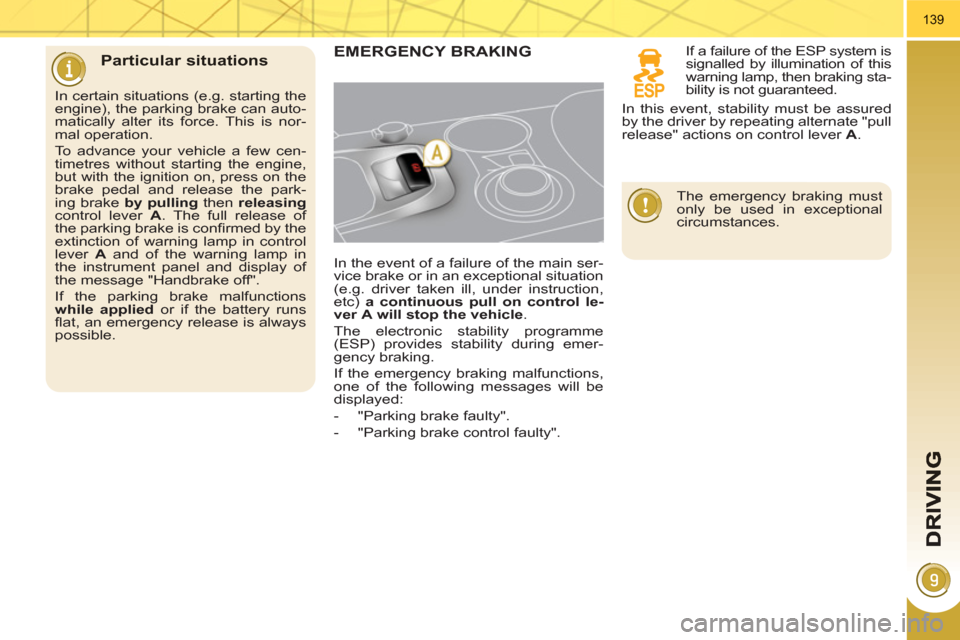
139
Particular situationsEMERGENCY BRAKING
In the event of a failure of the main ser-
vice brake or in an exceptional situation
(e.g. driver taken ill, under instruction,
etc) a continuous pull on control le-
ver
A
will stop the vehicle
.
The electronic stability programme
(ESP) provides stability during emer-
gency braking.
If the emergency braking malfunctions,
one of the following messages will be
displayed:
- "Parking brake faulty".
- "Parking brake control faulty".
In certain situations (e.g. starting the
engine), the parking brake can auto-
matically alter its force. This is nor-
mal operation.
To advance your vehicle a few cen-
timetres without starting the engine,
but with the ignition on, press on the
brake pedal and release the park-
ing brake by pulling
then releasing
control lever A
. The full release of
the parking brake is confi rmed by the
extinction of warning lamp in control
lever A
and of the warning lamp in
the instrument panel and display of
the message "Handbrake off".
If the parking brake malfunctions
while applied
or if the battery runs
fl at, an emergency release is always
possible.
If a failure of the ESP system is
signalled by illumination of this
warning lamp, then braking sta-
bility is not guaranteed.
The emergency braking must
only be used in exceptional
circumstances.
In this event, stability must be assured
by the driver by repeating alternate "pull
release" actions on control lever A
.
Page 142 of 280
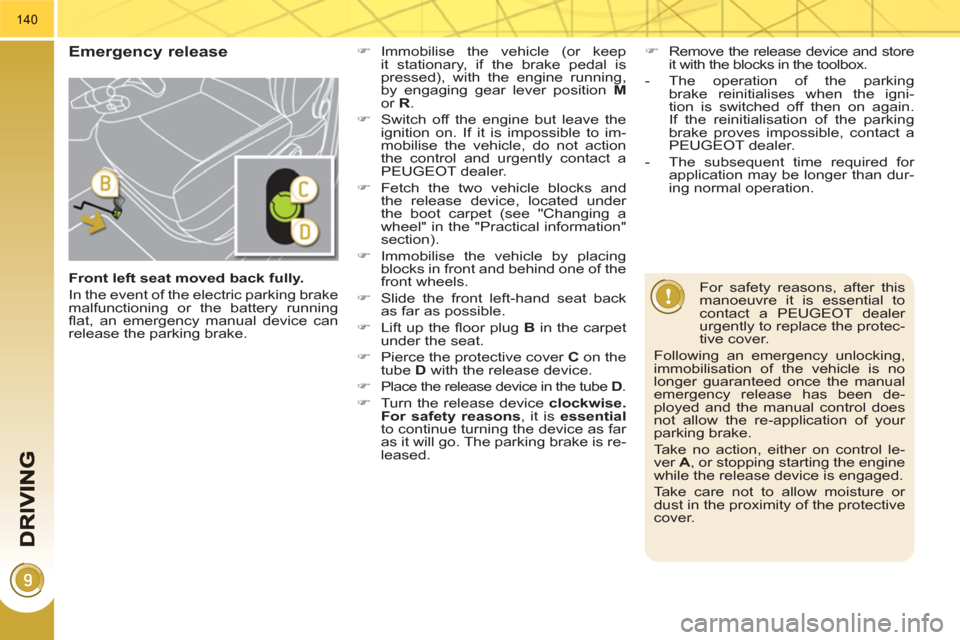
140
Emergency release
For safety reasons, after this
manoeuvre it is essential to
contact a PEUGEOT dealer
urgently to replace the protec-
tive cover.
Following an emergency unlocking,
immobilisation of the vehicle is no
longer guaranteed once the manual
emergency release has been de-
ployed and the manual control does
not allow the re-application of your
parking brake.
Take no action, either on control le-
ver A
, or stopping starting the engine
while the release device is engaged.
Take care not to allow moisture or
dust in the proximity of the protective
cover.
�)
Immobilise the vehicle (or keep
it stationary, if the brake pedal is
pressed), with the engine running,
by engaging gear lever position M
or R
.
�)
Switch off the engine but leave the
ignition on. If it is impossible to im-
mobilise the vehicle, do not action
the control and urgently contact a
PEUGEOT dealer.
�)
Fetch the two vehicle blocks and
the release device, located under
the boot carpet (see "Changing a
wheel" in the "Practical information"
section).
�)
Immobilise the vehicle by placing
blocks in front and behind one of the
front wheels.
�)
Slide the front left-hand seat back
as far as possible.
�)
Lift up the fl oor plug B
in the carpet
under the seat.
�)
Pierce the protective cover C
on the
tube D
with the release device.
�)
Place the release device in the tube D
.
�)
Turn the release device clockwise.
For safety reasons
, it is essential
to continue turning the device as far
as it will go. The parking brake is re-
leased.
�)
Remove the release device and store
it with the blocks in the toolbox.
- The operation of the parking
brake reinitialises when the igni-
tion is switched off then on again.
If the reinitialisation of the parking
brake proves impossible, contact a
PEUGEOT dealer.
- The subsequent time required for
application may be longer than dur-
ing normal operation.
Front left seat moved back fully.
In the event of the electric parking brake
malfunctioning or the battery running
fl at, an emergency manual device can
release the parking brake.
Page 144 of 280
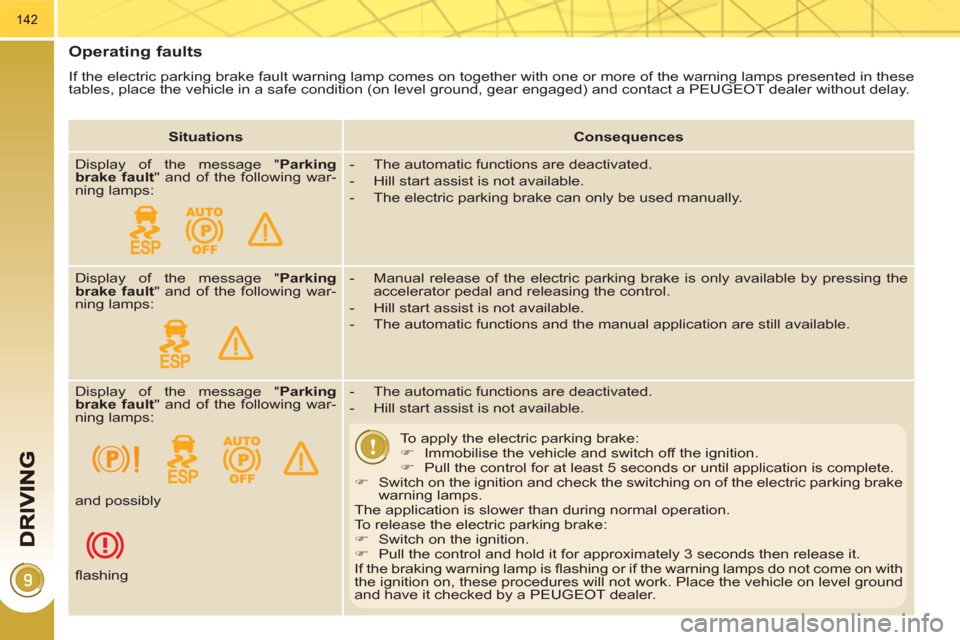
142
Operating faults
If the electric parking brake fault warning lamp comes on together with one or more of the warning lamps presented in these
tables, place the vehicle in a safe condition (on level ground, gear engaged) and contact a PEUGEOT dealer without delay.
Situations
Consequences
Display of the message " Parking
brake fault
" and of the following war-
ning lamps:
- The automatic functions are deactivated.
- Hill start assist is not available.
- The electric parking brake can only be used manually.
Display of the message " Parking
brake fault
" and of the following war-
ning lamps:
- Manual release of the electric parking brake is only available by pressing the
accelerator pedal and releasing the control.
- Hill start assist is not available.
- The automatic functions and the manual application are still available.
Display of the message " Parking
brake fault
" and of the following war-
ning lamps:
- The automatic functions are deactivated.
- Hill start assist is not available.
To apply the electric parking brake:
�)
Immobilise the vehicle and switch off the ignition.
�)
Pull the control for at least 5 seconds or until application is complete.
�)
Switch on the ignition and check the switching on of the electric parking brake
warning lamps.
The application is slower than during normal operation.
To release the electric parking brake:
�)
Switch on the ignition.
�)
Pull the control and hold it for approximately 3 seconds then release it.
If the braking warning lamp is fl ashing or if the warning lamps do not come on with
the ignition on, these procedures will not work. Place the vehicle on level ground
and have it checked by a PEUGEOT dealer. and possibly
fl ashing
Page 146 of 280
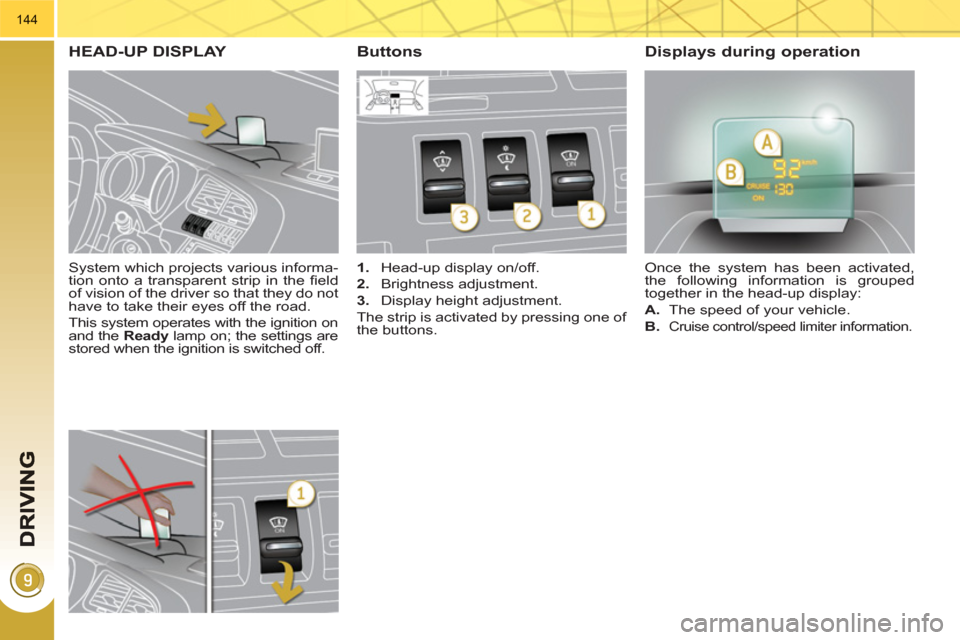
144
System which projects various informa-
tion onto a transparent strip in the fi eld
of vision of the driver so that they do not
have to take their eyes off the road.
This system operates with the ignition on
and the Ready
lamp on; the settings are
stored when the ignition is switched off.
HEAD-UP DISPLAY
1.
Head-up display on/off.
2.
Brightness adjustment.
3.
Display height adjustment.
The strip is activated by pressing one of
the buttons. Once the system has been activated,
the following information is grouped
together in the head-up display:
A.
The speed of your vehicle.
B.
Cruise control/speed limiter information.
Buttons Displays during operation